E. Kristin Anderson's Blog, page 17
August 29, 2014
Dear Westbrook High School
Dear Westbrook High School,
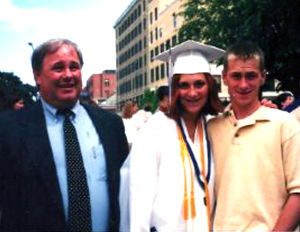
This is me at graduation, between my dad and my brother, who were both more popular at WHS than me!
Hi, remember me? Probably not. I graduated way back in 2001, and in those days then my name was Emily Morse. (Technically, it still is. We can talk about pen names another time.) Anyway, I wasn’t very legendary. I had a few awards from being on the track team, and occasionally I’d get some sort of acknowledgement from an English teacher. I think I got a medal for women’s citizenship at graduation, but I’m sad to say I can’t remember. Recently, my mom found my National Honor Society pin, which I’m amazed that I even had, considering what a shit show senior year was for me. That pin now sits on my dresser between my basket of clean socks and my 13″ TV with a built-in VCR. I guess you could say I like to hold on to things.
Anyway, the new school year is starting. As I write this, I’m at a coffee shop in Austin, Texas that’s about spitting distance from the neighborhood middle school. They’ve already started classes here in AISD, and at about 3pm, my beloved (air-conditioned) sanctuary will be invaded by middle school students. It’s cool. Teens are my peeps. But it makes me think of you guys.
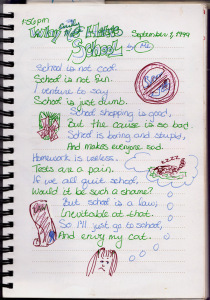
A highly literary excerpt from the journal I kept as a teen.
According to my dad, school is starting for y’all next week. And I thought I’d write you a note with a little bit of insight. Because, goddamn, high school feels so huge, doesn’t it? Not, like, in an OMG I’M IN HIGH SCHOOL WOW sort of way. (But, yeah, for freshmen, that can totally be the case. I felt that way.) But in a THIS IS MY ENTIRE WORLD sort of way. And that’s pretty overwhelming, isn’t it? Teachers and administrators have probably said the phrase “permanent record” in your presence at some point in the last few years. Or they’ve been talking about “if you want to get into college…” and all that stuff. Plus, you’re finding yourself navigating cliques, which I know for a FACT are super weird and tough in a small town. (BTW, if you didn’t know it, Westbrook is a small town. 16,000 people? Yeah, small. I know it’s not, like, you know, Aroostook County. But it’s small. Trust me. I didn’t figure this out until I was like 26, but it’s true.) So while you’re stressing about where to sit in the cafeteria or whether you’ll make new friends this year or if your friends will make fun of you for joining the math team or going out for track or if you even have a chance at making the football team (has the football team won a game recently? They SUCKED when I was at WHS) — well, I thought maybe you could use a few pointers.
WAIT. Don’t click away. They’re not those kind of pointers.
Actually, I only have one pointer.
BE NICE.
STOP IT. Stop rolling your eyes. I’m serious. I may not have learned a lot at Westbrook High, before I escaped to college and eventually to New York and later Texas (damn, it’s hot here! I miss real autumn!) — but I did learn the value of being nice. The hard way. I was the kid that got picked on in middle school. And I later became kind of hardened. I didn’t trust anyone. I was jealous. I was angry. I was pretty sure that the kids at my lunch table didn’t like me that much. And, you know what? Some of them didn’t.
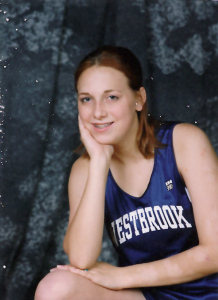
Me in my track team portrait, spring of senior year.
I did track almost every season that I was at WHS. I was even good at my event (racewalk) in the spring. Like, really good. But I wasn’t a jock. Sometimes the Most Popular Girl In School would give me a ride home. We had a lot of classes together. I’d known her since I was like six (small town, y’all…you know how that goes). She’d been mean to me in middle school, but that was in the past, right? Not for me. I didn’t trust her. I felt good when we would talk about music (The Cranberries, Foo Fighters), but never opened up. I found out in high school that I was struggling with mental illness. I found out in college that Popular Girl also did. Can you imagine what might have happened if either of us had been NICER to each other?
So when I say BE NICE, I’m not just talking to bullies. And I know you all have heard how bullies are bullies because they’re insecure. And I know that you don’t care about this when you’re being bullied because it HURTS. And, yeah, bullies? Be nice. Duh. And not-bullies? This all applies to you, too. It applies to everyone! Anyway, I thought it might be valuable for you to know a few things, from someone who has walked those same hallowed halls:
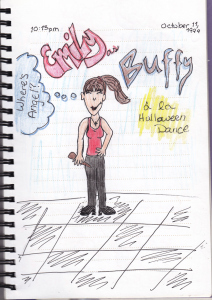
One of my favorite drawings from my high school journal.
1. The kid who made my life miserable in 6th grade looked me up on Facebook when we were 27 and APOLOGIZED to me. At length. He was embarrassed and ashamed. We’re FB friends now. If I ran into him while I was visiting Westbrook, I’d hug him.
2. The only people I’m still actually for realsies in touch with now from Westbrook are either related to me or people who I’ve reconnected with on Facebook post-college. (Given, we didn’t have FB when I was in college. I’m just saying, if you don’t want to stay in touch with people, you don’t have to. And if you want to re-connect later, you can!)
3. I can think of at least five people who were mean to me who have since come out as being gay, or having serious struggles with an eating disorder, or having seriously effed up family situations at home. Which means this: You don’t know what other people are dealing with. And while I FIRMLY believe that having a tough life doesn’t give you carte blanche to be an asshole, sometimes assholes need a bit of grace in order to be, uh, less of an asshole.
4. It’s okay if you fail trigonometry. I did. I’m doing okay for myself. But you should probably still be nice to your math teacher. (I used to draw pictures of angry people trash-talking trig as answers on my math tests. To be fair, I was kind of losing my mind at the time and my math teacher was kind of a jerk, but, you know…maybe not the best tactic.)
5. Only like six people went to my ten-year high school reunion. I was not one of them because it’s expensive as hell to fly from Texas to Maine in August.
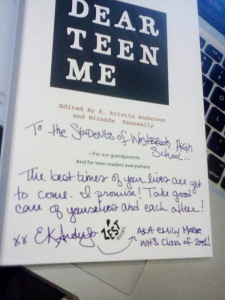
For WHS. I
6. The teacher who was a total jerk to me (and taught MOBY DICK, which I HATED with a fiery passion…which may or may not be his fault) was eventually fired in some sort of scandal involving weed and an affair with a student. According to rumor. So much schadenfreude, since he went easier on athletes on the team(s) he coached. All students should be treated equally, am I right?
7. I did go back to Westbrook High School in 2012 to bring y’all a copy of my first book, DEAR TEEN ME. The head librarian did not remember me, but remembered my brother and my dad. (My dad used to coach the hockey team.) One of the volunteers at the circulation desk was shocked to find out that someone from WHS had published a book. Guess what? There is nothing about WHS that limits you. NOTHING. Which brings me back to:
BE NICE.
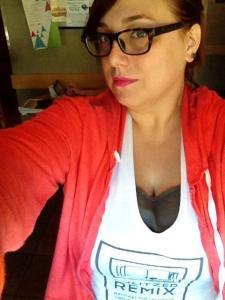
This is me now, at the aforementioned coffee shop. I’ve gained about 50lbs, but also so much knowledge and experience. Wouldn’t trade it.
I swear to you. Being a good person, a nice person, will open more doors for you than being captain of the (anything) team, or having perfect grades, or being popular or being a nerd. (Because, let’s face it, nerd is the new cool.) Being nice doesn’t mean being a doormat, of course. And it doesn’t mean you won’t have to be assertive, or ask for what you want, or reach hard and long for goals. But being nice is way more important than calculus or English or soccer or cliques or small towns or big cities.
So, Westbrook High School, I wish you all the best for your new school year. Make new friends. Take risks. Sit with people you haven’t ever sat with before. Take a class that scares you. Try out for a team you’re completely unqualified for. Go see a new band. Join a band. Write poems, write novels, write epics. Try not to be scared of math. (Make friends with someone good at math who can help you not be scared of math.) Go to homecoming stag. Ask your crush to homecoming. Ask for help when you need it, whether it’s for school, for relationships, or your health. And, above all, be nice. I’ll be thinking of you and wishing you well, from sunny Texas.
Especially when you’re shoveling your parents’ driveways this winter. Good effing luck with that. 
Love,
Emily Morse
WHS Class of 2001.





August 28, 2014
Review: TWO GIRLS STARING AT THE CEILING by Lucy Frank
I’ve long been a fan of novels in verse, and this new verse novel by Lucy Frank comes with a twist. TWO GIRLS STARING AT THE CEILING is the story of Chess, who is hospitalized the night after what should have been a high-school-movie-esque-party-turned-romance. But everything went impossibly wrong, and now she’s sharing a room with a sad old lady and one of the angriest girls she’s ever met. Chess’ room mate Shannon has a story to tell, too. And her no bullshit way of thinking — and talking — is crossing the curtain that divides their living space in the hospital. Here’s the twist: In this novel, the aforementioned curtain is represented by a line down the page. Each girl has her own space, her thoughts and her dialogue on whichever side of the curtain she happens to be standing. It could be considered nothing more than a clever gimmick, but the story is strong enough to power past this label.
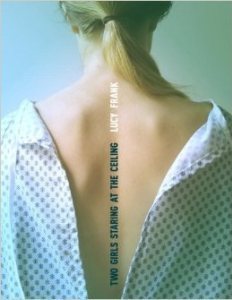
Schwartz & Wade, August 2014.
Chess is so embarrassed by her evening gone awry. And when she finally comes out of her meds-induced delirium, finding herself parked in a hospital room, she pretty much wishes she could just disappear. Chess never wants to see her crush again, and doesn’t even want her friends to visit. (A bestie’s brand new dress was ruined in the mortifying incident that landed her in the ER.) And she definitely doesn’t want anyone to know her diagnosis: Chron’s disease. Known also by it’s way less appealing (and much more humiliating) name, inflammatory bowel disease.
The thing is, Shannon isn’t going to let her wallow. Shannon has been through what Chess is dealing with, and she’s not going to pull any punches when it comes to giving unsolicited advice, going hard on the hospital staff, or asking for exactly what she wants. Chess is a please-and-thank-you sort of girl. But maybe there’s something she can learn from her bristly room mate. Her diagnosis — something she’s been trying to avoid, ignoring the pain, telling herself that every incident has been a coincidence — is terrifying. But maybe, with Shannon at her side, she can find the strength (despite the “evil juice” that is her medication) to face the rest of her life.
For fans of Sonya Sones and Wendy Mass, this is the type of book that sticks with you, opening up the world of an underrepresented illness and creating characters that are not only in the story but in your heart. Reluctant readers will love the unusual style and format, and verse novel lovers will gobble this one up as well. Get it on your shelves for fall!





August 27, 2014
Review: LIKE NO OTHER by Una LaMarche
Is it the worst ever if I say that LIKE NO OTHER by Una LaMarche is like no other? I loved this book in an ELEANOR AND PARK kind of way. The authentic voice(s), the real relationships, and the beautiful prose all came together for an unbelievably good read.
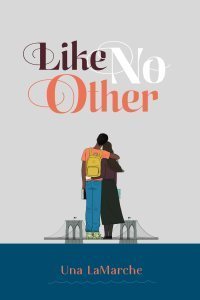
Razorbill, July 2014.
LIKE NO OTHER follows two teens who never should have met. Jaxon is a black boy of Caribbean descent from Brooklyn. And while Devorah is from the same neighborhood, she would never in a million years think of venturing to Jaxon’s side of the street. She’s a Hasidic Jew, and it’s forbidden for her to speak to strange men. Even if they are stuck in an elevator during a blackout.
Except, she does speak. And he’s wonderful. And, little by little, these two teens find themselves going against everything that they know is practical and right to see each other. They sneak around, defy their parents (which neither of them EVER do), and even ignore the advice of friends because they have never felt a feeling like this.
I’d hate to give away any of the good stuff — and there is so much good stuff — but this is a book in which the tension runs high. How could it not? Between Devorah’s controlling brother-in-law and Jaxon’s mischief-making pals, there’s no way to completely avoid trouble. The thing is, when you’re in love, trouble doesn’t really matter that much, does it?
Una LaMarche is a genius, and if you need the proof, it’s right here in LIKE NO OTHER. Deftly navigating cultural boundaries, this is a book that not only highlights a pocket of the US population we might never see (or choose to overlook), without drawing boundaries or passing judgement. Plus, if your heart aches for a sweet romance that has the high stakes of Simone Elkeles but the sweetness of Stephanie Perkins, this is a book you absolutely must read.





August 26, 2014
Review: I LOVE I HATE I MISS MY SISTER by Amélie Sarn
Sometimes a book comes along that punches you in the gut. This is one of those books. I LOVE I HATE I MISS MY SISTER by French author Amélie Sarn has recently been translated into American English so that all of us on this side of the Atlantic can feel that gut punch. Believe me, this is something you want.
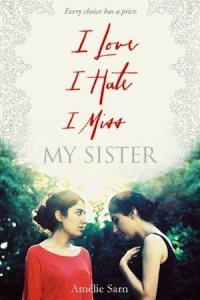
Delacorte Books for Young Readers, August 2014.
Skipping back and forth in time, this novel follows Sohane, the “good girl” to her younger sister Djelila’s “wild child.” While Djelila is taunted by neighborhood kids for not dressing modestly enough — tight jeans, short sweaters, a blonde streak in her hair — Sohane has recently decided to wear a hijab to school, even though it’s against the law in France to wear headscarves — or any overt religious symbols – in public schools. Sohane makes good grades, keeps to herself. Djelila plays basketball and has a crush on a boy and has popular girl friends. And while sometimes Sohane feels a sense of what can only be described as schadenfreude when her sister has to hear taunts from the wannabe gangsters in the projects, she cannot stand it when those taunts go to far. When Djelila is killed, everything Sohane thought she knew about herself, her community — both in her neighborhood and in her school — and her sister is tossed upside-down.
I LOVE I HATE I MISS MY SISTER is a story that is not only terrifying and intense, but also based on real events that happened in France not long ago. It’s a story that shines a light on a girl from a culture that many Americans don’t know very much a about, and it is a story that shines a light on a teenager who is just like many American girls — struggling with her own identity, coping with jealousy, and juggling both social pressure and pressure from school. The voice is authentic and real and beautiful. The story is harrowing. This book is such a quick read that once you’ve been sucked in you’ll stay sucked in until you turn the last page, with tears in your eyes. Amélie Sarn‘s new novel is a must-read for fans of realistic fiction that pulls no punches. I hope you find your way to it, ASAP.





August 25, 2014
Review: ONE DEATH, NINE STORIES edited by Marc Aronson & Charles R. Smith, Jr.
I love short story collections. LOVE them. You don’t see too many for the YA market, which is too bad. Fortunately, there’s a wonderful new collection out right now. And it’s a collection with a fabulous twist, since, despite being written by multiple authors, it pretty much reads like a novel.
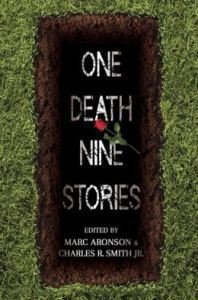
Candlewick Press, August 2014.
In ONE DEATH NINE STORIES, edited by Marc Aronson and Charles R. Smith, Jr., authors like Rita Williams-Garcia, Ellen Hopkins, A.S. King, Chris Barton, Nora Raleigh Baskin, and others answer a big what if: What if a teen’s death had a ripple effect in ways nobody could have predicted? The book opens with a story about an undertaker’s apprentice, bringing in the body of a boy named Kevin. It continues to explore Kevin’s death with each story, through the eyes of a different person. Some of these people were close to Kevin — his ex-girlfriend, a childhood friend. Others only knew him because he died, like the young cosmetologist working on him at the funeral home.
These stories, in an almost surprising way, tell both one story and nine. Each of the vignettes gives as much about the narrator as it does about Kevin. Simultaneously, each story is a piece of the puzzle that was Kevin. And which Kevin was the real Kevin? The troubled boyfriend? The charismatic leader? The loving brother? The wannabe gangster?
ONE DEATH, NINE STORIES is a beautiful collection, a fabulous story both as one and as nine. This will be a great book both for readers of literary fiction and fans of the above authors, as well as for young readers who might be reluctant to pick up a novel, due to the book’s short length and the unique format. Readers, find a copy for yourselves; English teachers, put this on your shelves for this fall!





August 21, 2014
Review: THE PRINCE OF VENICE BEACH by Blake Nelson
The latest from contemporary YA powerhouse Blake Nelson is so filled with joy and voice that it’s impossible to put down. And I say joy not because it’s necessarily a happy story — some pretty messed up stuff happens in THE PRINCE OF VENICE BEACH. After all, it’s about a homeless teen and his street kid pals, solving mysteries and trying to stay out of trouble. The joy comes from Cali, the aforementioned homeless teen, who is perhaps slightly less homeless than usual, since he’s taken up residence in a kindly woman’s tree house. Cali left home to find a new life. And he has. And he’s happy. Especially when word gets out that he knows everyone and everything that happens on Venice Beach, and the local police want him to help in investigations.
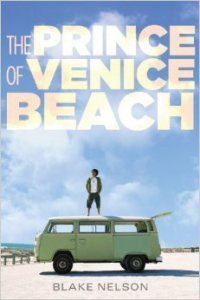
Little, Brown Books for Young Readers, June 2014.
It’s not long before Cali’s reputation gets him involved with private investigators, inspiring him to become a PI himself, and maybe even get his GED. But, he thing is, the PI’s he works with don’t always tell him what’s up with the people they’re looking for. He thinks he’s doing a good thing, but he isn’t so sure when he’s asked to track down a runaway girl — a beautiful girl, who doesn’t want to be found, ever, and for possibly good reasons. Cali has to decide what’s more important — his being a PI or this girl’s wishes. And he has to figure out if this girl is even telling him the truth.
Blake Nelson‘s characters are genuine, as gritty and real as the streets they call home. Cali’s story manages to shine a light on some of this grit, and find heart-warming truths in these “throwaway” kids — kids like traumatized, sweet Strawberry and the basketball prodigies with whom Cali spends his afternoons. THE PRINCE OF VENICE BEACH is beautifully written, a great summer read, and a great book for those who’d like to see a little more sand and sun in their noir.





August 19, 2014
Review: THE MERCILESS by Danielle Vega
It’s not every day that I pick up a book that makes me squirm. I have a pretty tough stomach for creepiness and violence and all that good stuff. I love shows like Dexter, have been known to watch horror movies alone in the dark, and one of my fave films when I was in high school was The Craft. (Still love it, BTW.) THE MERCILESS by Danielle Vega made me a little barfy. And I think it was good barfy, if there’s such a thing. It’s a send-up to Mean Girls taken to an extreme, with a side of Bible thumping and a little exorcism for flavor.
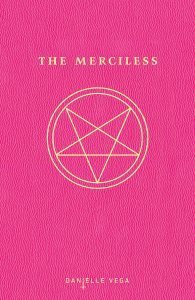
Razorbill, August 2014.
Sofia is the new girl in town, and, since her mother is in the military, she’s been the new girl a lot. Her past few experiences as the new girl have been pretty terrible, actually. She’s used to being mercilessly bullied. And she’s expecting about the same here, in this sweet southern suburb, until the queen bee Riley and her posse of popular girls take her under their collective wing. Sofia has also befriended outcast Brooklyn. And with all these new friends on her side, she thinks she’s got it pretty sweet. But Riley has a serious hate-on for Brooklyn, who apparently used to be part of the cool crowd. She’s changed — so much that Riley has become convinced that she’s possessed. And Riley’s obsessed with Brooklyn is about to lead Sofia and her new friends down a dark, terrifying path. A path that leads to an abandoned house that once was their girlie hangout and has now become the place where Riley & Co. plan to exorcize “demons” from Brooklyn by any means necessary. And Sofia will have to either prove her loyalty or end up the next one tied up in the basement. THE MERCILESS is probably one of the most scary YA novels I’ve read in a while. It’s not scary in the way that Nancy Holder is scary, or the way that Lois Duncan is scary. This is scary in the way that Stephen King at his goriest is scary . This is CARRIE on Steroids. Heathers meets Hostel. No punches are pulled. Nothing happens “off screen,” and the reader isn’t spared details. If you’re looking to have your blood curdled anytime soon, this is the book for you. 





August 15, 2014
Collecting Rejection
I have a shoebox full of rejections.
The shoebox once contained my favorite sneakers – a pair of PF Flyers that I bought when I first moved to New York in 2006. I’m sad to report that the sneakers are no longer with us. The rejections, however? I have every single one.
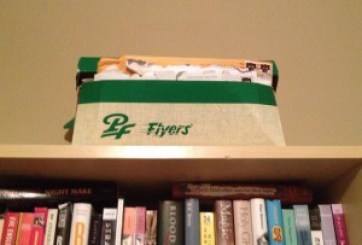
The Rejection Box.
When I first started submitting my poetry to magazines – around the same time I bought those shoes – I knew that I wasn’t going to get a whole lot of yeses. At least not right away. And probably not from the big names. The Paris Review, The New Yorker – these are the magazines that make careers. I was just starting. Paper submissions were still the preferred method with a lot of magazines, so I took the long way to the subway every day so that I could stop by the post office and get proper postage for my submissions. I dropped them into the mailbox, thinking that this time, at least ONE of these would come back with a yes.
It took a long time. Finally in the summer of 2007, I heard from an editor at a new magazine called Mimesis. They wanted to print a few of my poems. I was so proud. My roommate and I celebrated, probably with ice cream and bad TV – it’s hard to remember. And I didn’t tell many people then, but the editor was a longtime friend of mine and so I never really felt like that completely counted. But you know what? It did.
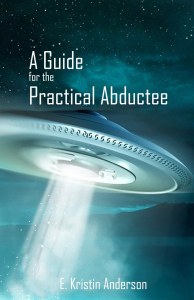
Red Bird Chapbooks, June 2014.
Over the past two years I’ve published work in magazines that I never thought would have me, like Asimov’s Science Fiction and Post Road. And sometimes when I say things like this – that I didn’t think I’d ever get into these magazines – people give me this look like, well if you didn’t think you were good enough, why did you even bother submitting?
And I get that. Because I have a box of rejections that proves their point. And I have an inbox of archived rejections that extra proves it. But I’ve often told writer friends as well as young writers asking for advice that you can’t win if you don’t play. And that’s kind of how this is, right? I have a copy of The Cimarron Review that proves my point. And so I sent work to The Paris Review and Poetry last month.
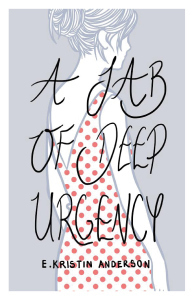
Finishing Line Press, October 2014.
This year has been a whirlwind for me, as a poet. My first chapbook, A GUIDE FOR THE PRACTICAL ABDUCTEE came out last month. (This was another yes that surprised me. This is too weird for chapbook publishers! I thought. I submitted anyway.) And I have a second chapbook, A JAB OF DEEP URGENCY, forthcoming in October. Most of you reading this post probably know me from DEAR TEEN ME, from kidlit events and all things YA. But, what many of you don’t know is that I’ve been wearing my poet hat for much longer. And I think that working in this crazy tough, uber-competitive field prepared me for the rejections that I’ve received since I moved to Austin, Texas and began writing YA. YA is also super tough and uber-competitive, and it’s been good to know that even with a box of rejections sitting in my library, I have a shelf full of magazines that have published my work.
I started collecting rejections probably because I’m a packrat. And then, because I’ve always been kind of an egomaniac and, at 23, I had the most wonderful delusions of grandeur, I thought, well, these rejections will keep me grounded when I’m a famous poet. (Because that’s a thing. No it’s not.) Truly, what they’ve become is a reminder that it takes a lot of rejections to get a yes. It takes making an effort every single day, regardless of your self-confidence or your faith in the universe to please-oh-please throw me a bone. And it takes being willing to accept rejection. Accept it, because it’s part of the game. Collect it, because you can’t win if you don’t play.





August 12, 2014
Review: THE UNFINISHED LIFE OF ADDISON STONE by Adele Griffin
I’ve never read a book like THE UNFINISHED LIFE OF ADDISON STONE. And I’ve read many other books by the author, Adele Griffin, who, by the way, is amazing. ADDISON STONE has been pitched as a “docu-novel.” It’s set up as somewhat of a biography of the fictional title character, Addison Stone, a young artist who left small-town New England for big-city New York only to end up dead at eighteen. Her death becomes scandal. Some say it’s an accident. Some say one or even both of her boyfriends could be involved. Some think that her history of mental health problems points to suicide.
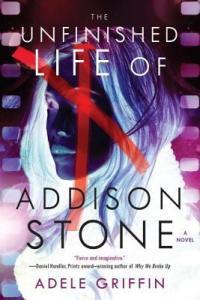
Soho Teen, July 2014.
But everyone agrees: Addison Stone was a prodigy, one of a kind. And there will never be another like her.
THE UNFINISHED LIFE OF ADDISON STONE is a unique reading experience. With visual art — pieces by Addison, discussed in the book — mixed in, along with portraits and snapshots of Addison, the book is narrated not only by the people Addison knew (from childhood besties to boyfriends to frenemies and teachers and family and the press) but her body of work. It’s easy to forget that this is a fictional account, that Addison is a character, and not a real girl. That these paintings and illustrations are work commissioned by Adele Griffin for her book, that the girl in the photos is not Addison, but a model.
In short? Read this book. Read it now. It’s beautiful and intense and the kind of book that stays with you, that makes your world both bigger and smaller. Meet Addison Stone, and hold her close to your heart.





August 11, 2014
Review: MARINA by Carolos Ruiz Zafón
The beautiful prose in MARINA is enough to suck any lover of words into Carlos Ruiz Zafón‘s latest. The setting of Barcelona in the 80s is another great hook. And then there’s the surrealism, the almost magically-real mystery. And the love story somewhat reminiscent of Alessandro D’Avenia’s WHITE LIKE MILK, RED LIKE BLOOD, or Rainbow Rowell’s ELEANOR & PARK. But, mostly, I think what makes MARINA a must-read (aside from, well, everything!) is the beautiful creep factor.
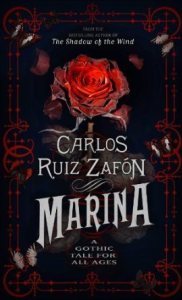
Little, Brown Books for Young Readers, July 2014.
Oscar is pretty much an average dude at a boarding school in Barcelona. But he’s also a loner. And he mostly likes it that way. He’s taken to sneaking out, spending weekends exploring the city. And on one such exploration he inadvertently a) experiences something that his rational brain can’t explain and b) breaks into an old mansion that turns out to not be as abandoned as he thought. When he goes back to return the watch that he accidentally stole in a rush of panic, he meets Marina. And, together, Oscar and Marina begin to unravel the mystery that began with Oscar’s encounter in her courtyard. And it’s a mystery that gets weirder and weirder — and, at the same time, lovelier and more grotesque.
Part Mary Shelley and part Maureen Johnson, MARINA is definitely a must-read for this summer…and fall. Fans of the classic Gothic will eat this novel up, and those looking to dip their toes into the genre won’t be disappointed, either. Carlos Ruiz Zafón knows how to spin a tale, and MARINA is a tale well-spun.








